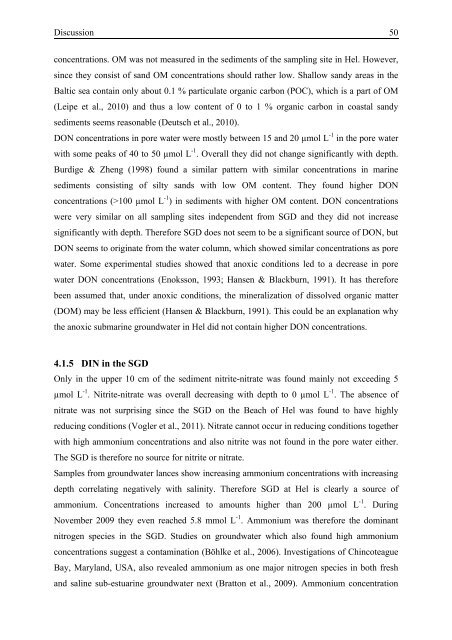Poland - IOW
Poland - IOW
Poland - IOW
You also want an ePaper? Increase the reach of your titles
YUMPU automatically turns print PDFs into web optimized ePapers that Google loves.
Discussion 50<br />
concentrations. OM was not measured in the sediments of the sampling site in Hel. However,<br />
since they consist of sand OM concentrations should rather low. Shallow sandy areas in the<br />
Baltic sea contain only about 0.1 % particulate organic carbon (POC), which is a part of OM<br />
(Leipe et al., 2010) and thus a low content of 0 to 1 % organic carbon in coastal sandy<br />
sediments seems reasonable (Deutsch et al., 2010).<br />
DON concentrations in pore water were mostly between 15 and 20 µmol L -1 in the pore water<br />
with some peaks of 40 to 50 µmol L -1 . Overall they did not change significantly with depth.<br />
Burdige & Zheng (1998) found a similar pattern with similar concentrations in marine<br />
sediments consisting of silty sands with low OM content. They found higher DON<br />
concentrations (>100 µmol L -1 ) in sediments with higher OM content. DON concentrations<br />
were very similar on all sampling sites independent from SGD and they did not increase<br />
significantly with depth. Therefore SGD does not seem to be a significant source of DON, but<br />
DON seems to originate from the water column, which showed similar concentrations as pore<br />
water. Some experimental studies showed that anoxic conditions led to a decrease in pore<br />
water DON concentrations (Enoksson, 1993; Hansen & Blackburn, 1991). It has therefore<br />
been assumed that, under anoxic conditions, the mineralization of dissolved organic matter<br />
(DOM) may be less efficient (Hansen & Blackburn, 1991). This could be an explanation why<br />
the anoxic submarine groundwater in Hel did not contain higher DON concentrations.<br />
4.1.5 DIN in the SGD<br />
Only in the upper 10 cm of the sediment nitrite-nitrate was found mainly not exceeding 5<br />
µmol L -1 . Nitrite-nitrate was overall decreasing with depth to 0 µmol L -1 . The absence of<br />
nitrate was not surprising since the SGD on the Beach of Hel was found to have highly<br />
reducing conditions (Vogler et al., 2011). Nitrate cannot occur in reducing conditions together<br />
with high ammonium concentrations and also nitrite was not found in the pore water either.<br />
The SGD is therefore no source for nitrite or nitrate.<br />
Samples from groundwater lances show increasing ammonium concentrations with increasing<br />
depth correlating negatively with salinity. Therefore SGD at Hel is clearly a source of<br />
ammonium. Concentrations increased to amounts higher than 200 µmol L -1 . During<br />
November 2009 they even reached 5.8 mmol L -1 . Ammonium was therefore the dominant<br />
nitrogen species in the SGD. Studies on groundwater which also found high ammonium<br />
concentrations suggest a contamination (Böhlke et al., 2006). Investigations of Chincoteague<br />
Bay, Maryland, USA, also revealed ammonium as one major nitrogen species in both fresh<br />
and saline sub-estuarine groundwater next (Bratton et al., 2009). Ammonium concentration
















